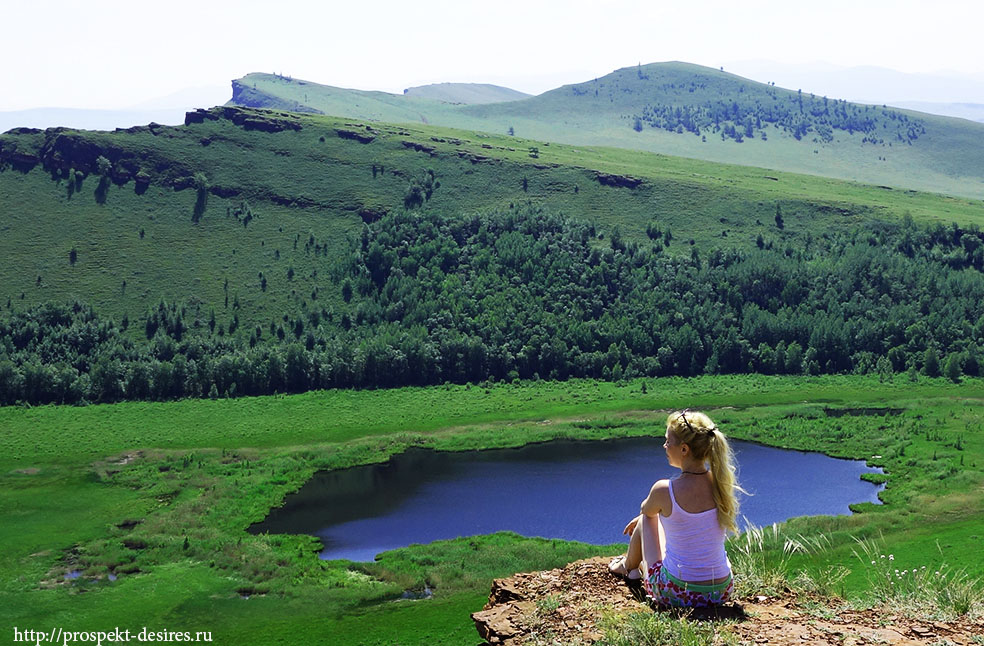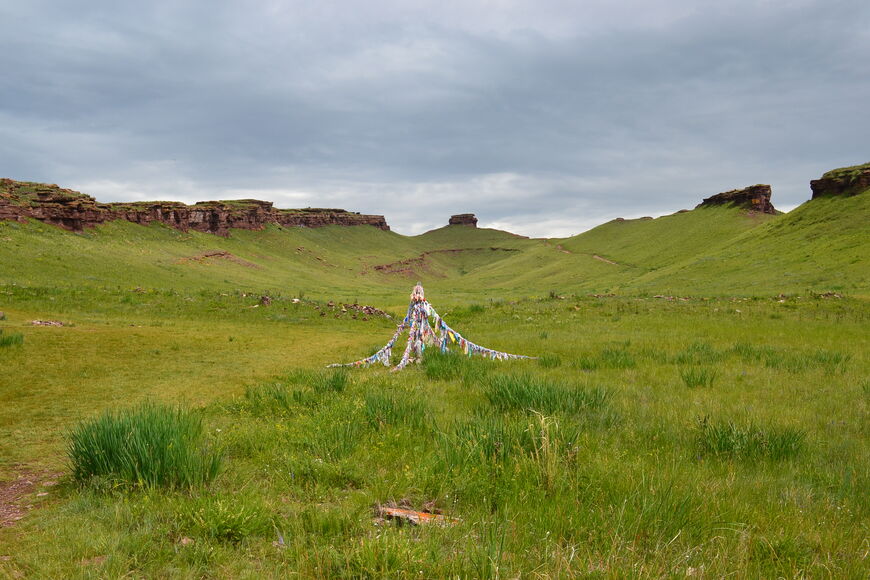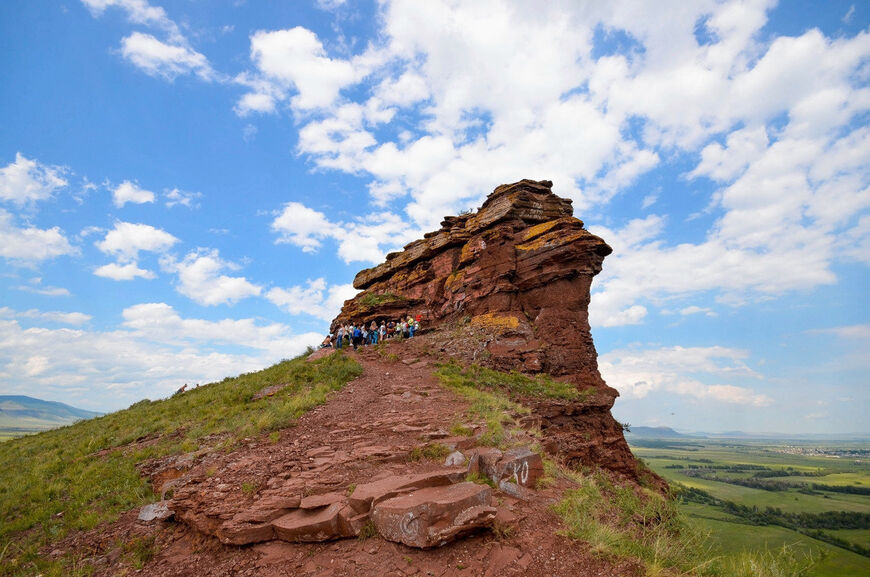REPUBLIC OF KHAKASIA - THE MIRACLE OF THE SIBERIAN LAND - PART TWO
 •
by
•
by Jasmmine
Hakasia is a vast country with incredible natural and archaeological treasures. In my previous article I told you a lot about it. And something remains unsaid and untouched yet...
Let's see it!
The Stonehenge of Khakassia
Everyone has heard about the brittish one. But in Russia there is a similar miracle - Sunduki


According to local legends mountain range was once guarded by bogatyr Hhohho-Babai, who became famous for his exploits. When he became rich, he lost his sight and asked the mountain spirits to help him. In return, the hero promised to give up his wealth, but after getting what he wanted, he did not keep his word. The angry spirits of the mountains turned him into a bird of prey, which still flies over its treasures. And the locals still call the first chest "Mount Hoho-Babay."
The chests have always been considered as one of the most mysterious and mystical places in Khakassia, radiating strength and energy. In ancient times, only devoted people could visit them. But even today the valley does not allow everyone to visit it, she can send bad weather or other unexplained incidents. Those who go there must have faith and pure intentions.

It is believed that the trip to the mountains will be successful if a blessing ritual is performed before leaving. For this purpose, a ribbon or piece of cloth should be tied to the sacrificial tree to soothe the spirits. Some seek the help of a shaman. He holds a ceremony to glorify the gods of the three worlds (Pravi, Javi, Navi) and prays for their blessing using fire.

Sunduki- this is a museum-reserve located in the valley of the Beli Ius River in the Republic of Khakassia. It is a ridge of several separate remote mountains. Some of them are up to 200 m high.
Sunduki got its name because of the correct cubic shape of the rock. The ancient Khakassian name of this mountain is "Hyzyl Haya", which means "Red Rock".
The multifunctional ancient complex covers an area of 2,100 hectares and consists of cemeteries, ancient rock paintings and special facilities with the help of which, ancient astronomers observed celestial bodies and kept records of calendar cycles.

There are about twenty hills in the mountain range. The most famous of these are nine, and only five have been studied. The first Sunduki- is the most interesting and significant in the chain. Seen from above, it has the shape of a horseshoe with a recess inside. And at the highest point there is a natural deviated rock, which is not completely destroyed by winds and rain.
According to the Novosibirsk archaeologist Larichev, the first Sunduki, as well as other hills in the valley between the rivers Beli and Cherni Ius, is the oldest astronomical observatory in Asia, which is about 16 thousand years old
According to other sources, everything here is prepared for observation of the sky (stones, holes and openings in the rocks, oriented to the points of sunrise and sunset of the celestial bodies on the days of the equinox and solstice).

During the period of the Tagar culture (VIII-III century BC) an artificial hole was made in the cube of the first chest, through which the sun's rays could penetrate only on the day of the winter solstice. This was a sign of the change of year, important for the economic and ritual activities of the people. There is even a place called the "shamanic chair" or "priest's throne" where the cyclical movements of the celestial bodies are observed.
Ancient stone-earth walls made of rows of horizontally and vertically laid stone slabs were also found on the first hill. There are two versions of the origin of the shaft. The first version is that these are the remains of a defensive structure, the second one is that these are the ruins of sanctuaries where rituals were performed and ghosts were associated with.

And on the rocky branches of the Fourth Sand with preserved unique drawings that carry a secret meaning. One of them is the famous painting "Lizhnik" which is only a fragment of a series of petroglyphs showing the mythology of modern times. The ancient images are about 4000 years old.
The most famous drawing is located on the slope of Solban peak - "White Horse". It is on 16,000 years old, compared to other sources - from 18 to 32 thousand years. The petroglyph is made by the method of splitting limestone salts. This is the only such image in Russia that resembles petroglyphs in France.

In front of the southernmost hill, Fifth Chest, there is a group of mounds. They are also an important part of the oldest observatory. It is here that the "Temple of Time" is located with a sundial in the form of a rock painting - a dragon, divided into six parts. By noon, the shadow moves from left to right, passing through a division for about an hour. At noon, the center point is fully illuminated, after which the shadow of the wall slides in the opposite direction.
There are many stone pyramids on the territory of the "Sunduki" reserve. They are built as pillars for prayers to forest spirits. They are built in special places and only with the permission of the shaman. It is believed that everything said next to the stone pyramids will definitely come true, as the wish immediately goes into space. There are also dark places where the stones have absorbed the energy of fear and death of the sacrifices that took place there.

There are other wonders - rectilinear irrigation canals dug two to five thousand years ago.
The amazing acoustics are also astounding. The words spoken at the top are clearly heard below, although the distance is 200-300 m. The miracle is explained by the shape of the mountain, which creates a kind of acoustic corridor for sound.
See you soon!
Jasmmine



Comments
First!
Go to Gulag!
Finally someone to tell him
Жаси, пусни няколко за Камчатка
Скоро за Шерегеш,следващата ще е за Камчатка 🙂
What's dis? 😮 Are the Russians coming? Liked the article though 😃
Вот🙃
Geological features are interesting.